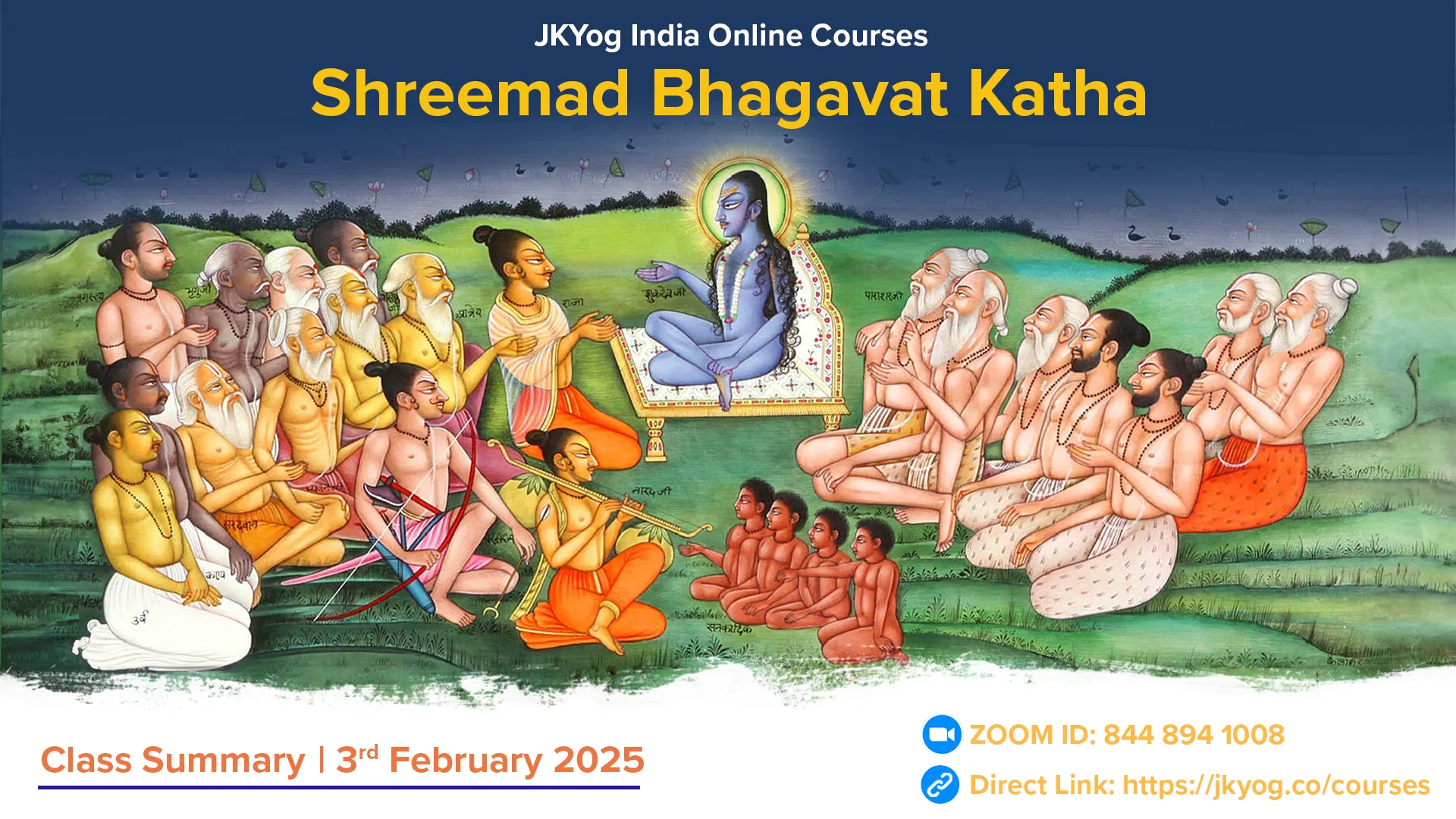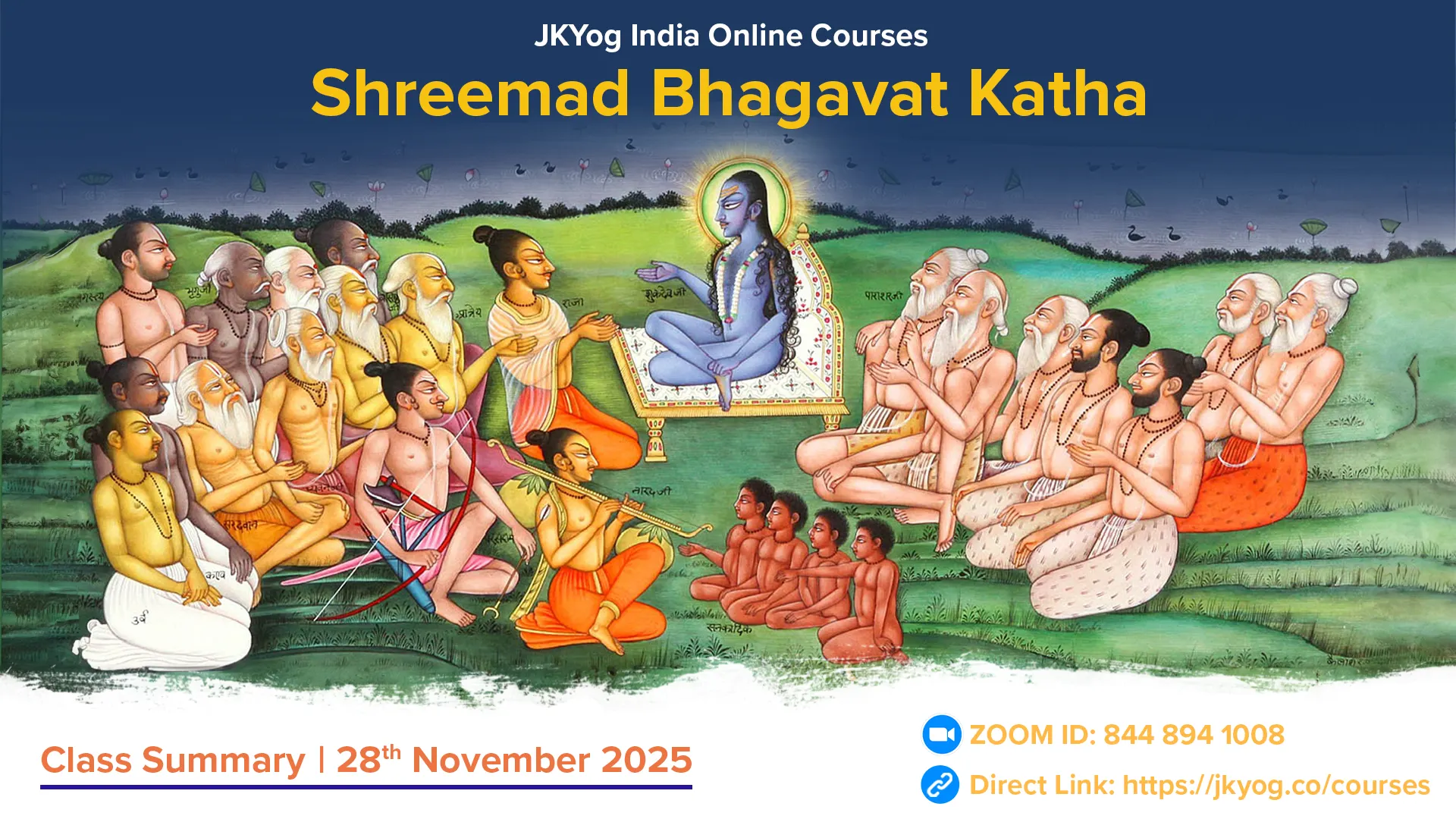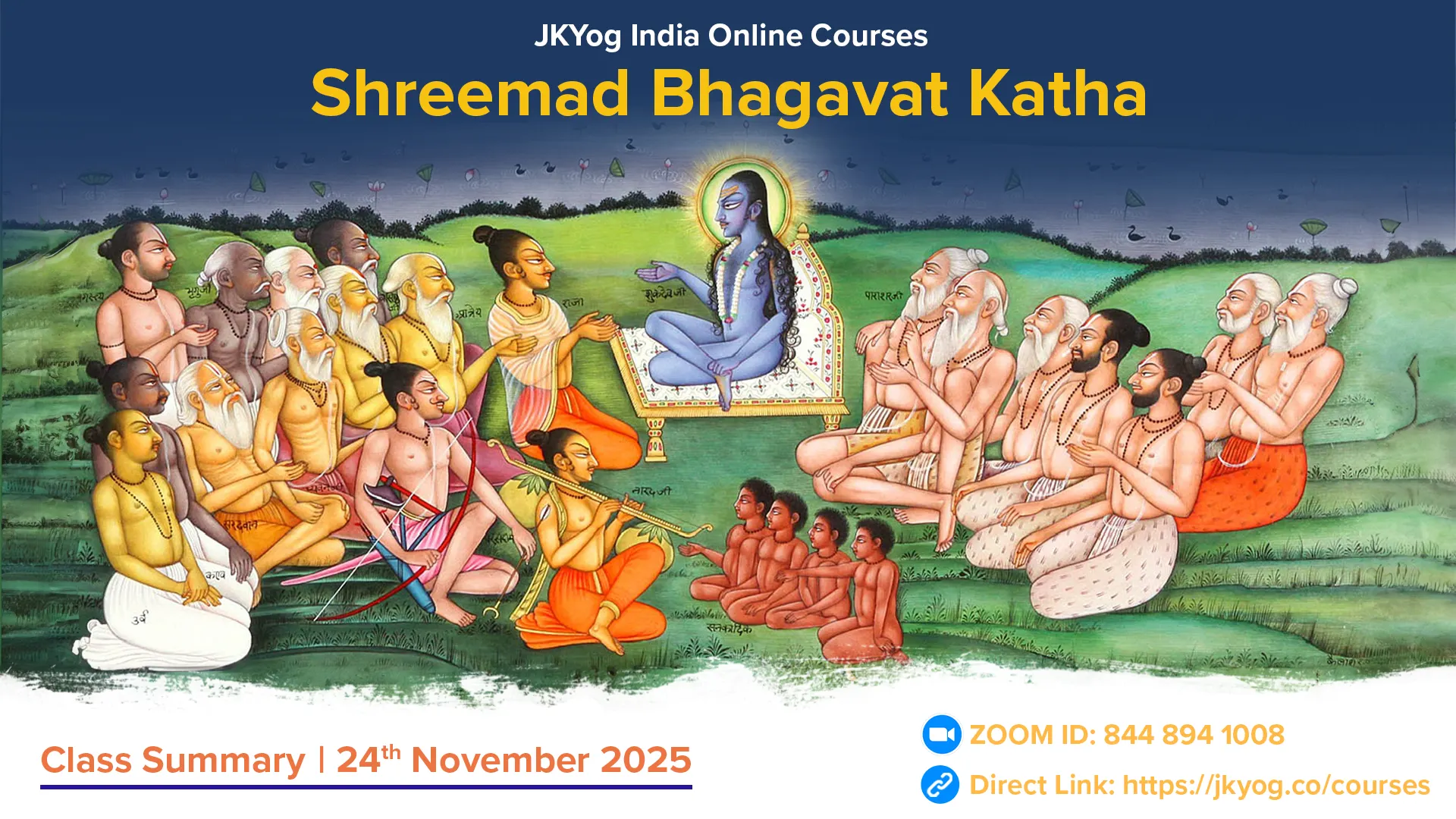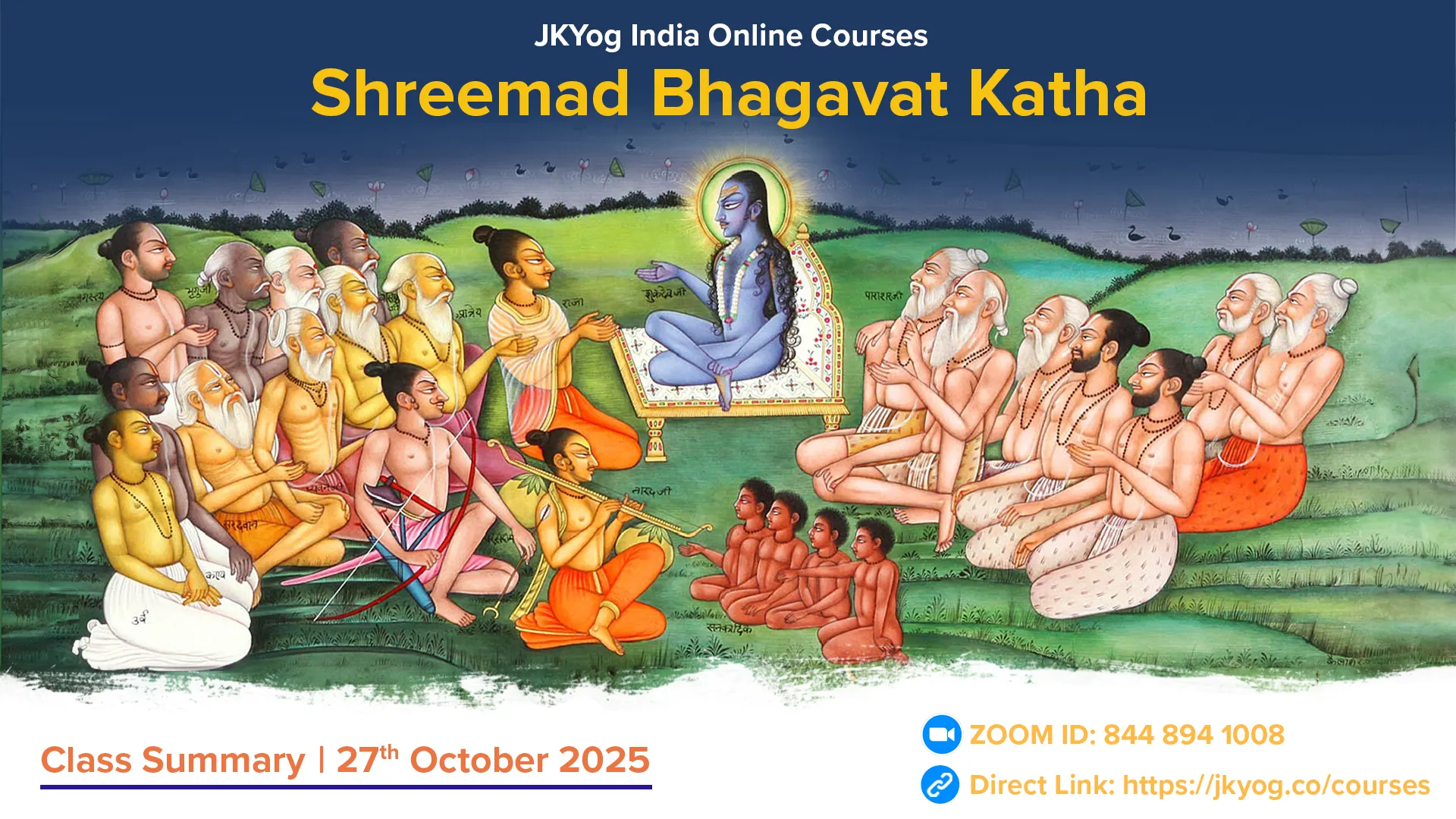Shreemad Bhagavat Mahapuran- Canto: 5, Chapter: 21-24
Shree Shukadevji says, "O King! I have described the expanse of this Bhulok to you. Based on this, learned scholars also estimate the measurement of Dyulok (Swarg/ heaven). Just as a grain of chickpea or pea is split into two halves, and by knowing one part, the other can be inferred, similarly, the wise say that the measurement of Dyulok can be known from that of Bhulok. Between these two lies the Antariksha-lok, which serves as their junction. Here, Bhagwan Surya, the ruler of the planets and constellations, continuously heats and illuminates the three Lokas with His radiance and energy."
Motion and Path of the Sun
The Sun's movement changes according to Uttarayan (Winter Solstice), Dakshinayan (Summer Solstice), and Vishuvat (Equinox), affecting the length of day and night. When the Sun is in the Mesha (Aries) or Tula (Libra) zodiac signs, day and night are equal. However, as it moves from Vrishabh (Taurus) to Vrishchik (Scorpio), the duration of day and night gradually changes. Scholars describe the Sun's circumambulation path around the Manasottar Mountain (situated on Pushkar Dweep) as 90,510,000 Yojans (760,800,000 miles).
On the Mansottar Mountain, Indra's city, Devdhani, lies to the east of Meru; Yamraj's city, Sayamani, to the south; Varun's city, Nimlochani, to the west; and Chandra's city, Vibhavari, to the north. As the Sun moves around Mount Meru, sunrise, noon, evening, and midnight occur in these cities at different times, regulating the activities of all living beings.
For those residing on top of the Meru Mountain, the Sun always blazes like it is noon. As the Sun moves towards the Ashwini Nakshatra (first lunar mansion) along with other constellations, it keeps Meru to its left. However, due to Pravaha Vayu, which constantly flows towards the right and causes the entire Jyotirmandal (celestial sphere) to rotate, the Sun appears to move towards the right.
When the Sun travels from Devdhani, the residence of Indra, to Sayamani, the residence of Yamaraj, it travels 23,775,000 yojanas [190,200,000 miles] in fifteen ghatikas (6 hours). From the residence of Yamaraj, the Sun travels to Nimlochani, the residence of Varun, from there to Vibhavari, the residence of the Moon god, and from there again to the residence of Indra. Along with the Sun, the Moon and other constellations also revolve in their respective orbits.
The Motion and Structure of the Sun's Chariot
The chariot of the Sun, which embodies the three Vedas (Rigved, Yajurved, and Samaved), travels 3,400,800 Yojans (27,206,400 miles) in one muhurta (48 minutes). This chariot has a single wheel called Samvatsar, which consists of twelve spokes (months), six segments (seasons), six rims, and three four-month periods (chaturmaas). One axle of this chariot is fixed on Manasottar Mountain, while the other end rests on Meru Mountain. The seating area (carriage) of the chariot extends 3,600,000 Yojans (28,800,000 miles) in length, and Arun, the charioteer, drives it.
The seven horses of this chariot symbolise the seven Vedic meters- Gayatri, Brihati, Ushnik, Jagati, Trishtup, Anushtup and Pankti. Leading Bhagwan Surya, 60,000 Valakhilya Rishis, each the size of a thumb, are constantly engaged in chanting auspicious hymns in His praise. Apart from them, Rishis, Gandharvas, Apsaras, Naags, Yakshas, Rakshasas, and Devas—collectively fourteen groups but paired as seven—worship Bhagwan Surya in pairs, taking on different names each month, performing distinct duties in His service. Bhagwan Surya traverses a massive circle of 95,100,000 Yojans (760,800,000 miles) around Bhulok, covering 2,002 Yojans (16,016 miles) every moment.
King Parikshit inquires how, when Surya moves through different zodiac signs, He appears to orbit Meru and Dhruvlok with them on His right. Yet, His actual motion is not southward (clockwise or dakshinavart).
Shree Shukadevji explains this phenomenon with an analogy: Just like an ant on a spinning potter’s wheel moves along with the wheel but still has its own movement, appearing at different spots at different times, the sun and planets also move within the wheel of time (Kaal Chakra) that carries the constellations and zodiac signs. Even though they seem to move with the wheel, their motion is separate, which is why they appear in different zodiac signs and constellations at different times.
As the sun moves through the twelve months on the Kaal Chakra, it passes through twelve different zodiac signs and assumes twelve different names accordingly. The total of these twelve months is called a Samvatsar (one full year). According to the lunar system (Chandramana), a month consists of two fortnights—one of the waxing moon (Shukla Paksha) and the other of the waning moon (Krishna Paksha). In Pitrilok (the realm of ancestors), this same period is considered one full day and night. According to Nakshatra System (Stellar Calculation), a month equals two and one quarter constellations. When the sun traverses one-sixth of the Samvatsar (year), that portion is called a Ritu (season), which is also a part of the Samvatsar.
The path of Bhagwan Surya in the sky is divided into two halves, and the time He takes to traverse one half is called an Ayana. Depending on whether Surya moves at a fast, slow, or uniform pace, His movement across the celestial sphere—including Swarg, Prithvi, and the entire sky—is described by different terms- Samvatsar, Parivatsar, Idavatsar, Anuvatsar and Vatsar.
The Motion and Position of the Moon, Planets, Constellations, Saptarishi Mandal, and Dhruvlok
The Moon is situated 100,000 Yojans (800,000 miles) above the Sun. It moves faster than all the constellations and completes the Sun’s yearly path in just one month, a month's path in about two and a quarter days, and a fortnight’s path in a single day. The Moon determines the day and night of the Pitris (ancestors) during the waning phase (Krishna Paksha) and of the Devas (gods) during the waxing phase (Shukla Paksha). Each day, it crosses one constellation in 30 muhurtas (approx. 12 hours). The Moon is annamaya (source of nourishment), amritamaya (source of nectar), and manomaya (linked to the mind), making it the life force of all beings. As Chandradev possesses sixteen kalaas (phases), he nourishes the pranas (vital energies) of devas, Pitris, humans, ghosts, animals, birds, reptiles, and trees, which is why he is called Sarvamaya (all-pervading).
Three hundred thousand Yojans (2.4 million miles) above the Moon are 28 constellations, including Abhijit Nakshatra, which move in a clockwise direction around Meru Parvat. Another 200,000 Yojans (1.6 million miles) above them is Venus (Shukra), which sometimes moves ahead of, behind, or alongside the Sun. As Venus governs rainfall, it usually remains favorable and calms planets that hinder rain.
Mercury (Budh) is positioned 200,000 Yojans above Venus and behaves similarly. Though generally auspicious, if it moves contrary to the Sun, it indicates storms, clouds, and drought. Mars (Mangal) is located 200,000 Yojans above Mercury. It divides each zodiac sign into three parts unless it moves in retrograde and is considered inauspicious, often signaling misfortune.
Jupiter (Brihaspati) lies 200,000 Yojans above Mars and takes one year to cross each zodiac sign. It is favorable for Learned persons and spiritual knowledge. Saturn (Shani) is 200,000 Yojans above Jupiter, staying in each zodiac sign for 30 months and taking 30 years to complete a full cycle. It is associated with delays, challenges, and unrest. Each of these planets influences human life by bestowing auspicious or inauspicious results.
Above all these, 1.1 million Yojans (8.8 million miles) away, are the Saptarishis (Ursa Major/Big Dipper), who constantly offer prayers for universal welfare and circumambulate Dhruvlok (Pole Star), the supreme abode of Bhagwan Vishnu. 1.3 million Yojans (10.4 million miles) above them lies Dhruvlok, where Dhruv, the son of Uttanapad, resides. Agni, Indra, Prajapati Kashyap, and Dharma reverently circumambulate this celestial realm, which remains firm until the end of the Kalpa.
The planets, stars, and other celestial bodies that constantly move in the cosmos are operated by Bhagwan Kaal and He has established Dhruvlok as the central pivot for all these celestial bodies. Just as when bulls are yoked together and tied to a central post to thresh rice, they walk in circles around the pivot, each staying in its designated position — one closest to the post, another in the middle, and the third further out. In a similar way, all the planets and countless stars revolve around the pole star, Dhruvlok, each following its unique orbit — some higher, some lower, the planets and constellations are also bound to the Dhruvlok. Driven by cosmic winds, they continue their journey until the end of the Kalpa.
Just as clouds with hundreds of tons of water float in the air or as the birds, due to the results of past activities, fly high in the sky and have no chance of falling to the ground, these celestial bodies remain suspended in space, never falling to the Earth, as they move in alignment with the interplay of Prakriti (Maya Shakti) and Purush (chit-shakti).
The Concept Cosmic Dolphin- Shishumar
Some learned beings describe this Jyotirmandal (celestial sphere), consisting of the stars and planets, resembles the form of a Shishumar (dolphin). This great cosmic dolphin is curled, with its face facing downward. At the tip of its tail is Dhruvlok. In the middle part of the tail are Prajapati, Agni, Indra, and Dharma. At the root of the tail are Dhata and Vidhata. In the waist region of the dolphin are the seven sages (Saptarishi).
The body of the dolphin is curled to the right, with the fourteen constellations of Uttarayan on the right side and the fourteen constellations of Dakshinayan on the left. On its back are a group of constellations known as the Azvithi, and in its belly is the Milky Way. On the right and left sides of the dolphin are the constellations of Pushya, Ardra, Ashlesha, Abhijit, and Uttarashadha. Among its other parts are the Sun, Moon, Jupiter, Mars, Saturn, and other planets, all of which represent the order and balance of the universe. Shree Shukdevji tells Parikshit, "O King! This dolphin is the complete divine form of Bhagwan Vishnu. One should meditate upon it at the evening time, silently and in purity, while contemplating on it as the Supreme Personality, the source of all gods, the embodiment of the time cycle, and the eternal divine being."
Shree Shukdevji says, "Parikshit! Some believe that Rahu is situated 10,000 yojans (80,000 miles) below the Sun and moves in the same way as the stars. Though an asura, by the grace of Bhagwan Vishnu, he became a planet. The birth and deeds of Rahu will be explained later. The extent of the orbits of the Sun, Moon, and Rahu are 10,000, 12,000, and 13,000 yojans, respectively. During the time of the nectar distribution, Rahu, in the form of a deity, sat between the Sun and the Moon. At that time, the Sun and the Moon revealed his true nature, and recalling that enmity, Rahu attacks them on the days of Amavasya (new moon) and Purnima (full moon). Upon witnessing this, Bhagwan Vishnu appointed His beloved weapon, the Sudarshan Chakra, to protect the Sun and Moon. It continuously spins, causing Rahu to become disturbed by its unbearable light, and Rahu briefly stops before them and then swiftly returns. This brief moment of his halt is called 'grahan' (eclipse).
Below Rahu, at a distance of 10,000 yojans (80,000 miles), are the places of the Siddhas, Charanas, and Vidyadharas. Beneath them, up to the speed of the wind and where clouds are visible, lies the realm of the Antariksha (the space). This is the abode of Yaksas, Rakshasas, Pishachas, Pretas, and Ghosts. Below that, at a distance of one 100 yojans (800 miles), lies the Earth (Bhulok). The limit of this realm is where prominent birds like swans, vultures, hawks, and Garuda can fly.
From Atal to Patal: The Realms Below Earth, Where Wealth Exceeds That of Heaven
Below the Earthly realm or Bhulok are seven subterranean realms named Atal, Vital, Sutal, Talatal, Mahatal, Rasatal, and Patal. These realms are situated one below the other, each at a distance of 10,000 yojans (80,000 miles). Each realm has a length and width of ten thousand yojans as well. These realms are considered types of heaven, possessing more pleasures, opulence, joy, progeny, and wealth than heaven itself. The inhabitants of these realms, including demons, danavs, and naags, live in grand palaces, gardens, and playgrounds, engaging in illusory sports. They all adhere to the dharma of household life. Their families, including wives, children, relatives, and servants, love them dearly and remain perpetually happy. Even gods like Indra cannot disrupt their enjoyment.
The palaces in these realms are created by the illusory powers of the Maya Danav, shining brightly with buildings made of gems and adorned with temple gates and courtyards. Naags, asuras, and birds play and thrive on the land, while the grand palaces of the rulers of Patal add to the beauty of these realms. The gardens are divine, laden with fruits and flowers, and teeming with fish in the ponds. The sunlight does not penetrate these realms, so there is no distinction between day and night. The inhabitants consume mystic potions that keep them youthful, healthy, and beautiful. They do not suffer from disease or old age. Their death only comes through the divine weapon of Bhagwan Vishnu, the Sudarshan Chakra. The gems on the heads of the naags dispel the darkness in these realms.
Atal Lok:
In Atal Lok, the son of the Maya Danav, Asura Bal, resides. He has created sixty-four types of illusion, and some of them still exist among the illusionary beings today. Once, when he yawned, three types of women were born from his mouth: Svairini (who only associates with men of her own kind), Kaamini (who associates with men of different kinds), and Punschali (who is extremely restless). These women, with their enchanting glances, loving smiles, conversations, and embraces, make the men in that realm drink a potion called "Haatak Ras," which intoxicates them and makes them feel powerful as if they are stronger than ten thousand elephants. They then boast, saying, "I am God, I am enlightened."
Vital Lok:
Below Atal is Vital Lok, where Bhagwan Haatkeshwar, a form of Mahadev, resides with his attendants, the bhootas. He and Goddess Bhavani engage in acts of creation and expansion, and a great river named Haataki emerges from their divine energy. The Fire eagerly consumes its water and spits out the gold called Haatak, which is used to make jewels for the men and women of that realm.
Sutal Lok:
Below Vital is Sutal Lok, where Bali, the son of Virochana, resides. Bhagwan Vishnu incarnated as Vamana and took all three worlds from him. However, with Bhagwan Vishnu's grace, Bali was allowed to enter this realm, where he now possesses wealth greater than even Indra. He continues to worship the supreme Lord and lives fearlessly in this realm.
Shukdevji tells King Parikshit, "O King, this is not the true result of donating land (as Bali Maharaj did). Donating (daan) with pure devotion and faith can lead to liberation (moksha) or attaining Divine Love.
In contrast, if a person chants the Divine Name of God even once in moments of distress—whether from hunger, stumbling, or falling — he can instantly break free from the cycle of karma. True devotees, whose hearts are filled with love for the Supreme Lord, realise that liberation and the awakening of pure love for Shree Krishna are the true rewards of devotion.
God does not grant material wealth and pleasures to His devotees as that can cause one to become distracted and forget His divine presence. The wealth given to Bali Maharaj, though significant, was simply temporary material enjoyment. The true reward of devotion is the awakening of pure love for the Divine."
Talatal Lok:
Below Sutal lies Talatal, where the demon-king Maya Danav, the ruler of Tripura, resides. Initially, Bhagwan Shiva destroyed his three cities to restore peace across the three worlds. Following this, Maya Danav was granted this realm as a boon. As the supreme guru of the illusory beings, he is shielded by Bhagwan Shiva's protection, making him fearless even in the face of the Sudarshan Chakra. The inhabitants of Talatal hold him in great reverence.
Mahatal Lok:
Below Talatal is Mahatal, which is inhabited by many serpents with multiple heads, born of Kadru. The prominent ones are Karkotak, Takshak, Kaliya, and Shushen. Though they are powerful and have large hoods, they live in fear of Lord Vishnu's vehicle, Garuda, and sometimes, intoxicated by their own pleasures, they venture out with their wives, children, and families.
Rasatal Lok:
Below this is Rasatal, where the daityas and danavas named Pani reside. They are also known as Nivatakavacha, Kaleya, and Hiranyapurvasi. These beings are opposed to the devatas. From birth, they are very powerful and courageous. However, due to the divine energy of Shree Hari, their pride in strength is shattered. As a result, they live in hiding, like serpents, and are always fearful of Indra, especially due to the mantras and incantations spoken by Indra's messenger, Sarma.
Patal Lok:
Below Rasatal is Patal, where the Naags with many hoods, such as Shankh, Kulik, Mahashankh, Shvet, Dhananjay, Dhritarashtra, Shankhchud, Kambal, Ashwatara, and Devadutt, reside. Among them, Vasuki is the chief. Some have five, seven, ten, or even a thousand heads, and their hoods shine with jewels that dispel the darkness of Patal Lok.
Summary: JKYog India Online Class- Shreemad Bhagavat Katha [Hindi]- 03.02.2025








